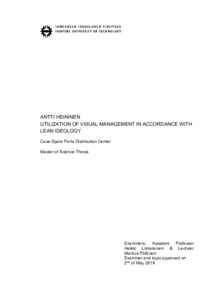Utilization of visual management in accordance with lean ideology
Heininen, Antti (2018)
Heininen, Antti
2018
Tietojohtaminen
Talouden ja rakentamisen tiedekunta - Faculty of Business and Built Environment
This publication is copyrighted. You may download, display and print it for Your own personal use. Commercial use is prohibited.
Hyväksymispäivämäärä
2018-08-15
Julkaisun pysyvä osoite on
https://urn.fi/URN:NBN:fi:tty-201808142107
https://urn.fi/URN:NBN:fi:tty-201808142107
Tiivistelmä
This thesis focuses on Lean ideology and visual management. Lean itself is an ideology of which main target is to highlight the meaning of customer value and reduce waste from different processes. Visual management in turn is one tool of Lean ideology. The basic idea of visual management is the visualization of information. The case distribution center (DC) is starting their journey towards a Leaner organization and visual management boards are one of the first steps in this journey. Nowadays each team inside the case DC has their own visual management board but the boards could be more visual. The aim of this thesis is to find out how visual management boards can ease the case DC to move towards a Leaner organization culture.
The thesis consists of two parts, theoretical and empirical. The theoretical part concentrates on supply chain management and Lean ideology. The first one is gone through as the case DC is a crucial factor in the supply chain. The Lean chapter introduces different ways to support the ideology of Lean. Both theoretical chapters support the understanding of the research problem. In the end of both theoretical chapters the introduced theories are connected to the case DC. The empirical part of this thesis has been done as a case study. To understand the current states of visual management boards and to identify the needs for the future visual management boards, theme interviews were arranged. Based on observations and the results of interviews, an analysis of the current visual management boards was created. In addition to this, the needs for the future visual management boards from different point of views were also analyzed.
The results of this thesis are improvement actions which can be divided to two categories: short-term and long-term improvements. The basis for the actions of this thesis are the theoretical and empirical studies. The short-term improvements are actions which should be possible to implement during the next six months while even the start of the long-term improvement actions could take a long time. Based especially on the empirical study, a model for daily visual management board was created. The most important factors of the model are showing the team’s status and emphasize continuous improvement. In addition to the created model for example needs for new visual management boards and agenda for the daily meetings were detected.
The thesis consists of two parts, theoretical and empirical. The theoretical part concentrates on supply chain management and Lean ideology. The first one is gone through as the case DC is a crucial factor in the supply chain. The Lean chapter introduces different ways to support the ideology of Lean. Both theoretical chapters support the understanding of the research problem. In the end of both theoretical chapters the introduced theories are connected to the case DC. The empirical part of this thesis has been done as a case study. To understand the current states of visual management boards and to identify the needs for the future visual management boards, theme interviews were arranged. Based on observations and the results of interviews, an analysis of the current visual management boards was created. In addition to this, the needs for the future visual management boards from different point of views were also analyzed.
The results of this thesis are improvement actions which can be divided to two categories: short-term and long-term improvements. The basis for the actions of this thesis are the theoretical and empirical studies. The short-term improvements are actions which should be possible to implement during the next six months while even the start of the long-term improvement actions could take a long time. Based especially on the empirical study, a model for daily visual management board was created. The most important factors of the model are showing the team’s status and emphasize continuous improvement. In addition to the created model for example needs for new visual management boards and agenda for the daily meetings were detected.
